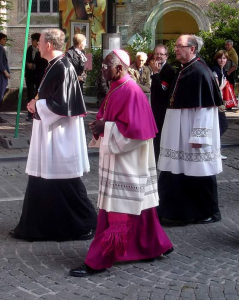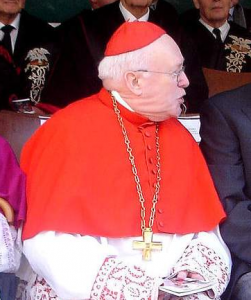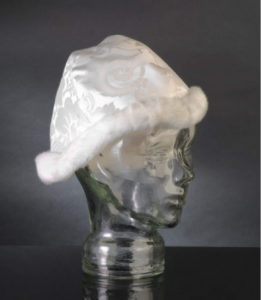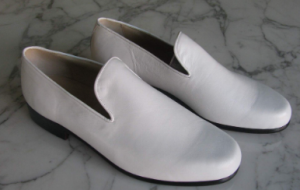| The Mozzetta of the Pope |
| „The mozzetta is a cape-like collar with a miniature hood, buttoned up in a row at the front. It is the privilege of the cardinals and bishops to wear it. Yet the canons of extraodinary cathedrals and collegiate churches may also be entitled to it by the Pope. The mozzetta consists of silk or noble wool. In the case of the cardinals, it may be either red or violet. The rest of the prelates wear violet ones, unless the cardinals and prelates do not belong to an order with its own special habit. In the latter case, the mozzetta will be the same colour as the habit, just like the cappa magna.
Numerous different opinions exist as to the age of the mozzetta. Some even see it rooted in Early Christianity which is all the more blatant since it is a very young vestment indeed. It is unlikely that the mantellum mentioned in the Ordo of Gregory X at the desciption of the feast after the papal election (“cardinales omnes habebunt superpellieeum cum camisia et mantello”) is identical with the mozzetta. However, it has been worn from the second half of the 15th century on at the very least. This fact can be derived from Melozzo da Forli’s fresco “Sixtus IV appointing Platina as Prefect of the Vatican Library”, depicting Pope Sixtus IV enrobed with a rochet and mozetta. The picture was painted in 1477. It is uncertain from what time on the mozetta was considered an exclusively episcopal vestment. This notion has already existed in the 16th century. It is possible, or even quite likely, that it has been prevalent from the very beginning. Regarding its origin, the mozzetta is usually related to the cappa. It is considered a shortened cappa, so that its name can be derived from mozzo which is Italian for mutilated (from mozzare, to cut off). This connection has been made by Pallavieino already in his history of the Council of Trent. It is commonly known that the mozzetta was subject to heated discussions at this very synod because the Spanish bishops insisted on wearing their mozzettas during the sessions. Others prefer to link the mozetta to the almuce. Indeed, the almuce in the form of a collar covering the shoulders and the mozzetta are fairly similar. Moreover that, the derivation of the term mozzetta is not more difficult than that of the word “Mütze” (German for hat) which developed during the late Middle Ages from alinuela. Hence, one could not say with certainty which interpretation is the right one. What is striking about the uncertainty of its origins is the fact that the first appearance of this vestment does not even date back very far. Keeping this difficulty in mind, one could hardly be astounded any longer if there are persisting controversities as to the origin of liturgical vestments which date back to early Christianity.” Braun, Joseph: Die Liturgische Gewandung im Occident und Orient – nach Ursprung und Entwicklung, Verwendung und Symbolik, Herdersche Verlagshandlung, Freiburg, 1904, pages 357-358 © Bild: Carl Cleas Clergy and bishop enrobed with the mozzetta The mozzetta of the Pope has a small hood at the backside. The Pope has got 5 different mozzettas whose use is specified by especially strict rules regarding the times, ceremonies and festivities (the following citations in Italics are quoted from (Stefano Sanchiricio, papal master of ceremonies, in: The Popes in white and red, L’Osservatore Romano, issue nr. 36, 10 Sept 2001, pages 8-9) 1. Mozzetta made from red satin, no ermine trimmings „The first hooded version made from red satin has no ermine trimmings. It was supposed to match the silk robe and used to be worn from the first vespers on the day of the Ascension of Jesus on, until the feast of Saint Catherine of Alexandria (November 25th).” 2. Mozzetta made from red velvet, lined with ermine „The second version was made from red velvet with an inner lining made from ermine. It had a hood as well. It was supposed to match the silk robe and was taken on at the feast of Saint Catherine. Just before the day of the Ascension of Jesus, it was switched for the satin one again.“ [Please note: The mozzetta of Pope Benedict XVI is not lined with ermine but is only trimmed with ermine on the fringes.] 3. Mozzetta made from red silk camelot, lined with silk, no ermine trimmings „The third hooded mozzeta made from red silk camelot or serge used to be worn over the same period of time as the silk mozzetta. It was worn during the vigils, the ember days and masses held for the deceased. It was meant to correspond to the so-called woollen robe.” 4. Mozzetta made from red cloth, lined with ermine „The fourth version was made from red cloth, lined with ermine and had a hood as well – but during the times of repentance of the church year only: i.e. Advent and the Lenten season, except for the feasts and solemnities, particularly the fest of the Immaculate Conception of Mary, as well as the anniversaries of the election and coronation of the Pope. It was meant to correspond to the so-called woollen robe as well. The mozzettas corresponding to the woollen robe are used for processions and liturgies of repentance, as well as for stational liturgies etc.” 5. Mozzetta made from white silk damask, lined with ermine „Finally, the mozzetta lined with ermine made from white silk damask was worn during the Octave of Easter. Prior to the reform of the Holy Week by Pope Pius XII it was put on after the papal chapel on the morning of Holy Saturday. It was taken off again before the Pope began to prepare for Saturday’s papal chapel “in albis”. After the reform of the Holy Weeks, it was only put on after the Vigile of Easter and kept on until Sunday’s second vesper “in albis”.” [Please note: the mozzetta of Pope Benedict XVI is not lined, but only trimmed with ermine on the fringes.] A red mozzetta is combined with red shoes and a red camauro, the white mozzetta is combined with white shoes and the white camauro. Red: White: Related literature: Braun, Joseph: Die Liturgische Gewandung im Occident und Orient – nach Ursprung und Entwicklung, Verwendung und Symbolik, Herdersche Verlagshandlung, Freiburg, 1904, pages 357-358 Mozzetta in: Lexikon für Theologie und Kirche (LThK), Herder Verlag, Freiburg Sanchiricio Stefano, papal master of ceremonies in: Die Päpste in weiß und rot (2.470 KB), L’Osservatore Romano, A German Weekly, issue nr. 36, 10 Sept 2010, pages 8-9 |









